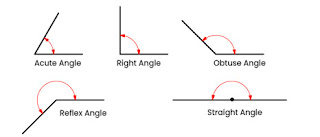Mathematical types of angles: Each angle has a unique measure and is formed when two rays or lines intersect at a place. Acute, obtuse, right, reflex, and straight angles can all be used to describe these angles of various measurements. Angle pairs come in a variety of shapes and sizes. Let's take a closer look at the various points of view.
Acute Angle
Less than 90 degree angles are referred to as acute angles. A smaller than 90° angle is created when two rays cross at a vertex or a point, creating an acute angle. A few instances of sharp angles are 20, 30, 45, and 60 degrees. PQR is an acute angle, as can be seen by looking at the diagram.
Right Angle
When the angle created by two rays is exactly 90 degrees, a right angle is created. It is also known as a 90-degree angle due to its unique definition.
Angle AOB is referred to as a right angle since it has a 90 degree angle. A square between the two rays is always used to indicate a correct angle.
Obtuse Angle
Greater than 90 degrees but less than 180 degrees is an obtuse angle.
In the diagram, the angle formed by the rays PQ and QR is acute.
Obtuse angles include those of 110°, 130°, 145°, and 165°.
Straight Angle
A straight angle is, as its name suggests, a straight line where the angle formed by two rays is precisely 180°. The two rays are directly across from one another. A straight angle can be created by joining two adjacent right angles together, or by joining two right angles together. In the diagram, ABC is a straight angle or a 180° angle.
Reflex/Mirror Angle
An angle that is greater than 180 degrees but less than 360 degrees is referred to as a reflex angle. The reflex angle in the diagram is DEF. Reflex angles include those of 210°, 250°, and 310°.
Know more about Types of Angles for Class 5

Comments
Post a Comment
Thank you we will contact ASAP.